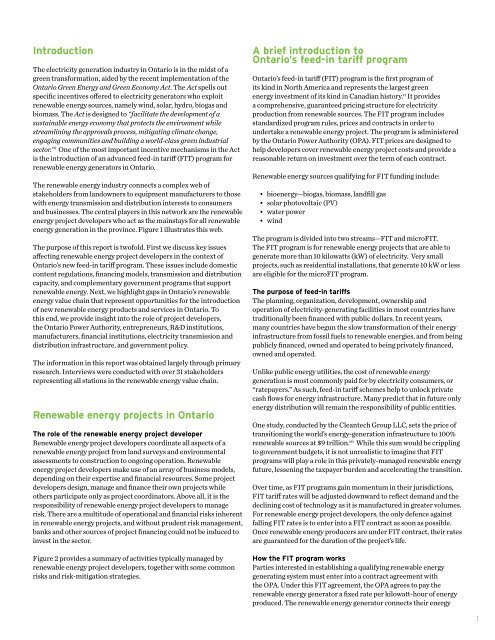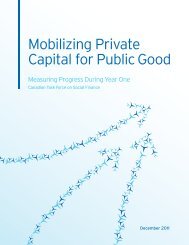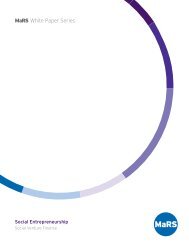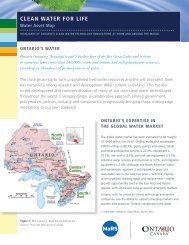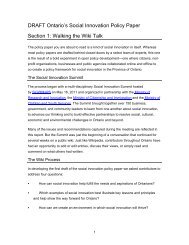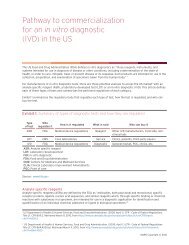Feed-in tariffs Accelerating renewable energy project development ...
Feed-in tariffs Accelerating renewable energy project development ...
Feed-in tariffs Accelerating renewable energy project development ...
Create successful ePaper yourself
Turn your PDF publications into a flip-book with our unique Google optimized e-Paper software.
Introduction<br />
The electricity generation <strong>in</strong>dustry <strong>in</strong> Ontario is <strong>in</strong> the midst of a<br />
green transformation, aided by the recent implementation of the<br />
Ontario Green Energy and Green Economy Act. The Act spells out<br />
specific <strong>in</strong>centives offered to electricity generators who exploit<br />
<strong>renewable</strong> <strong>energy</strong> sources, namely w<strong>in</strong>d, solar, hydro, biogas and<br />
biomass. The Act is designed to “facilitate the <strong>development</strong> of a<br />
susta<strong>in</strong>able <strong>energy</strong> economy that protects the environment while<br />
streaml<strong>in</strong><strong>in</strong>g the approvals process, mitigat<strong>in</strong>g climate change,<br />
engag<strong>in</strong>g communities and build<strong>in</strong>g a world-class green <strong>in</strong>dustrial<br />
sector.” i One of the most important <strong>in</strong>centive mechanisms <strong>in</strong> the Act<br />
is the <strong>in</strong>troduction of an advanced feed-<strong>in</strong> tariff (FIT) program for<br />
<strong>renewable</strong> <strong>energy</strong> generators <strong>in</strong> Ontario.<br />
The <strong>renewable</strong> <strong>energy</strong> <strong>in</strong>dustry connects a complex web of<br />
stakeholders from landowners to equipment manufacturers to those<br />
with <strong>energy</strong> transmission and distribution <strong>in</strong>terests to consumers<br />
and bus<strong>in</strong>esses. The central players <strong>in</strong> this network are the <strong>renewable</strong><br />
<strong>energy</strong> <strong>project</strong> developers who act as the ma<strong>in</strong>stays for all <strong>renewable</strong><br />
<strong>energy</strong> generation <strong>in</strong> the prov<strong>in</strong>ce. Figure 1 illustrates this web.<br />
The purpose of this report is twofold. First we discuss key issues<br />
affect<strong>in</strong>g <strong>renewable</strong> <strong>energy</strong> <strong>project</strong> developers <strong>in</strong> the context of<br />
Ontario’s new feed-<strong>in</strong> tariff program. These issues <strong>in</strong>clude domestic<br />
content regulations, f<strong>in</strong>anc<strong>in</strong>g models, transmission and distribution<br />
capacity, and complementary government programs that support<br />
<strong>renewable</strong> <strong>energy</strong>. Next, we highlight gaps <strong>in</strong> Ontario’s <strong>renewable</strong><br />
<strong>energy</strong> value cha<strong>in</strong> that represent opportunities for the <strong>in</strong>troduction<br />
of new <strong>renewable</strong> <strong>energy</strong> products and services <strong>in</strong> Ontario. To<br />
this end, we provide <strong>in</strong>sight <strong>in</strong>to the role of <strong>project</strong> developers,<br />
the Ontario Power Authority, entrepreneurs, R&D <strong>in</strong>stitutions,<br />
manufacturers, f<strong>in</strong>ancial <strong>in</strong>stitutions, electricity transmission and<br />
distribution <strong>in</strong>frastructure, and government policy.<br />
The <strong>in</strong>formation <strong>in</strong> this report was obta<strong>in</strong>ed largely through primary<br />
research. Interviews were conducted with over 31 stakeholders<br />
represent<strong>in</strong>g all stations <strong>in</strong> the <strong>renewable</strong> <strong>energy</strong> value cha<strong>in</strong>.<br />
Renewable <strong>energy</strong> <strong>project</strong>s <strong>in</strong> Ontario<br />
The role of the <strong>renewable</strong> <strong>energy</strong> <strong>project</strong> developer<br />
Renewable <strong>energy</strong> <strong>project</strong> developers coord<strong>in</strong>ate all aspects of a<br />
<strong>renewable</strong> <strong>energy</strong> <strong>project</strong> from land surveys and environmental<br />
assessments to construction to ongo<strong>in</strong>g operation. Renewable<br />
<strong>energy</strong> <strong>project</strong> developers make use of an array of bus<strong>in</strong>ess models,<br />
depend<strong>in</strong>g on their expertise and f<strong>in</strong>ancial resources. Some <strong>project</strong><br />
developers design, manage and f<strong>in</strong>ance their own <strong>project</strong>s while<br />
others participate only as <strong>project</strong> coord<strong>in</strong>ators. Above all, it is the<br />
responsibility of <strong>renewable</strong> <strong>energy</strong> <strong>project</strong> developers to manage<br />
risk. There are a multitude of operational and f<strong>in</strong>ancial risks <strong>in</strong>herent<br />
<strong>in</strong> <strong>renewable</strong> <strong>energy</strong> <strong>project</strong>s, and without prudent risk management,<br />
banks and other sources of <strong>project</strong> f<strong>in</strong>anc<strong>in</strong>g could not be <strong>in</strong>duced to<br />
<strong>in</strong>vest <strong>in</strong> the sector.<br />
Figure 2 provides a summary of activities typically managed by<br />
<strong>renewable</strong> <strong>energy</strong> <strong>project</strong> developers, together with some common<br />
risks and risk-mitigation strategies.<br />
A brief <strong>in</strong>troduction to<br />
Ontario’s feed-<strong>in</strong> tariff program<br />
Ontario’s feed-<strong>in</strong> tariff (FIT) program is the first program of<br />
its k<strong>in</strong>d <strong>in</strong> North America and represents the largest green<br />
<strong>energy</strong> <strong>in</strong>vestment of its k<strong>in</strong>d <strong>in</strong> Canadian history. vi It provides<br />
a comprehensive, guaranteed pric<strong>in</strong>g structure for electricity<br />
production from <strong>renewable</strong> sources. The FIT program <strong>in</strong>cludes<br />
standardized program rules, prices and contracts <strong>in</strong> order to<br />
undertake a <strong>renewable</strong> <strong>energy</strong> <strong>project</strong>. The program is adm<strong>in</strong>istered<br />
by the Ontario Power Authority (OPA). FIT prices are designed to<br />
help developers cover <strong>renewable</strong> <strong>energy</strong> <strong>project</strong> costs and provide a<br />
reasonable return on <strong>in</strong>vestment over the term of each contract.<br />
Renewable <strong>energy</strong> sources qualify<strong>in</strong>g for FIT fund<strong>in</strong>g <strong>in</strong>clude:<br />
• bio<strong>energy</strong>—biogas, biomass, landfill gas<br />
• solar photovoltaic (PV)<br />
• water power<br />
• w<strong>in</strong>d<br />
The program is divided <strong>in</strong>to two streams—FIT and microFIT.<br />
The FIT program is for <strong>renewable</strong> <strong>energy</strong> <strong>project</strong>s that are able to<br />
generate more than 10 kilowatts (kW) of electricity. Very small<br />
<strong>project</strong>s, such as residential <strong>in</strong>stallations, that generate 10 kW or less<br />
are eligible for the microFIT program.<br />
The purpose of feed-<strong>in</strong> <strong>tariffs</strong><br />
The plann<strong>in</strong>g, organization, <strong>development</strong>, ownership and<br />
operation of electricity-generat<strong>in</strong>g facilities <strong>in</strong> most countries have<br />
traditionally been f<strong>in</strong>anced with public dollars. In recent years,<br />
many countries have begun the slow transformation of their <strong>energy</strong><br />
<strong>in</strong>frastructure from fossil fuels to <strong>renewable</strong> energies, and from be<strong>in</strong>g<br />
publicly f<strong>in</strong>anced, owned and operated to be<strong>in</strong>g privately f<strong>in</strong>anced,<br />
owned and operated.<br />
Unlike public <strong>energy</strong> utilities, the cost of <strong>renewable</strong> <strong>energy</strong><br />
generation is most commonly paid for by electricity consumers, or<br />
“ratepayers.” As such, feed-<strong>in</strong> tariff schemes help to unlock private<br />
cash flows for <strong>energy</strong> <strong>in</strong>frastructure. Many predict that <strong>in</strong> future only<br />
<strong>energy</strong> distribution will rema<strong>in</strong> the responsibility of public entities.<br />
One study, conducted by the Cleantech Group LLC, sets the price of<br />
transition<strong>in</strong>g the world’s <strong>energy</strong>-generation <strong>in</strong>frastructure to 100%<br />
<strong>renewable</strong> sources at $9 trillion. vii While this sum would be crippl<strong>in</strong>g<br />
to government budgets, it is not unrealistic to imag<strong>in</strong>e that FIT<br />
programs will play a role <strong>in</strong> this privately-managed <strong>renewable</strong> <strong>energy</strong><br />
future, lessen<strong>in</strong>g the taxpayer burden and accelerat<strong>in</strong>g the transition.<br />
Over time, as FIT programs ga<strong>in</strong> momentum <strong>in</strong> their jurisdictions,<br />
FIT tariff rates will be adjusted downward to reflect demand and the<br />
decl<strong>in</strong><strong>in</strong>g cost of technology as it is manufactured <strong>in</strong> greater volumes.<br />
For <strong>renewable</strong> <strong>energy</strong> <strong>project</strong> developers, the only defence aga<strong>in</strong>st<br />
fall<strong>in</strong>g FIT rates is to enter <strong>in</strong>to a FIT contract as soon as possible.<br />
Once <strong>renewable</strong> <strong>energy</strong> producers are under FIT contract, their rates<br />
are guaranteed for the duration of the <strong>project</strong>’s life.<br />
How the FIT program works<br />
Parties <strong>in</strong>terested <strong>in</strong> establish<strong>in</strong>g a qualify<strong>in</strong>g <strong>renewable</strong> <strong>energy</strong><br />
generat<strong>in</strong>g system must enter <strong>in</strong>to a contract agreement with<br />
the OPA. Under this FIT agreement, the OPA agrees to pay the<br />
<strong>renewable</strong> <strong>energy</strong> generator a fixed rate per kilowatt-hour of <strong>energy</strong><br />
produced. The <strong>renewable</strong> <strong>energy</strong> generator connects their <strong>energy</strong><br />
1


